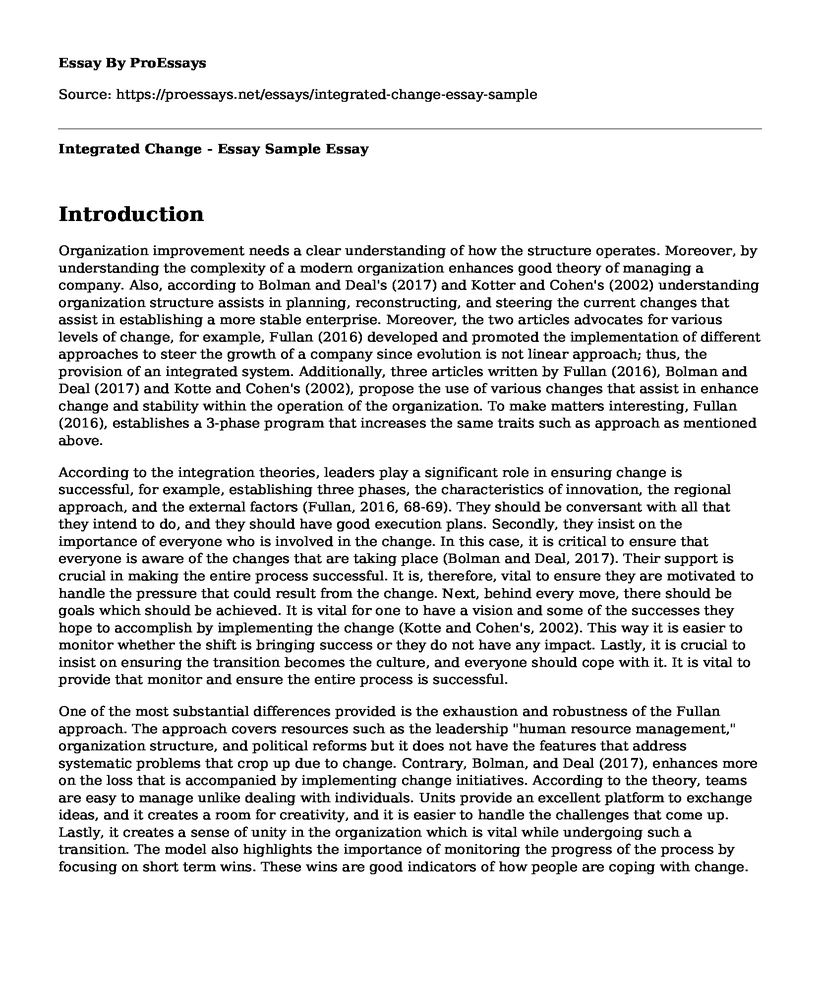Introduction
Organization improvement needs a clear understanding of how the structure operates. Moreover, by understanding the complexity of a modern organization enhances good theory of managing a company. Also, according to Bolman and Deal's (2017) and Kotter and Cohen's (2002) understanding organization structure assists in planning, reconstructing, and steering the current changes that assist in establishing a more stable enterprise. Moreover, the two articles advocates for various levels of change, for example, Fullan (2016) developed and promoted the implementation of different approaches to steer the growth of a company since evolution is not linear approach; thus, the provision of an integrated system. Additionally, three articles written by Fullan (2016), Bolman and Deal (2017) and Kotte and Cohen's (2002), propose the use of various changes that assist in enhance change and stability within the operation of the organization. To make matters interesting, Fullan (2016), establishes a 3-phase program that increases the same traits such as approach as mentioned above.
According to the integration theories, leaders play a significant role in ensuring change is successful, for example, establishing three phases, the characteristics of innovation, the regional approach, and the external factors (Fullan, 2016, 68-69). They should be conversant with all that they intend to do, and they should have good execution plans. Secondly, they insist on the importance of everyone who is involved in the change. In this case, it is critical to ensure that everyone is aware of the changes that are taking place (Bolman and Deal, 2017). Their support is crucial in making the entire process successful. It is, therefore, vital to ensure they are motivated to handle the pressure that could result from the change. Next, behind every move, there should be goals which should be achieved. It is vital for one to have a vision and some of the successes they hope to accomplish by implementing the change (Kotte and Cohen's, 2002). This way it is easier to monitor whether the shift is bringing success or they do not have any impact. Lastly, it is crucial to insist on ensuring the transition becomes the culture, and everyone should cope with it. It is vital to provide that monitor and ensure the entire process is successful.
One of the most substantial differences provided is the exhaustion and robustness of the Fullan approach. The approach covers resources such as the leadership "human resource management," organization structure, and political reforms but it does not have the features that address systematic problems that crop up due to change. Contrary, Bolman, and Deal (2017), enhances more on the loss that is accompanied by implementing change initiatives. According to the theory, teams are easy to manage unlike dealing with individuals. Units provide an excellent platform to exchange ideas, and it creates a room for creativity, and it is easier to handle the challenges that come up. Lastly, it creates a sense of unity in the organization which is vital while undergoing such a transition. The model also highlights the importance of monitoring the progress of the process by focusing on short term wins. These wins are good indicators of how people are coping with change.
Conclusion
To conclude, change is inevitable and when it is the right time for change an organization should consider various factors. Kotlers' model is better in various aspects, and it is more likely to bring successful changes in an organization. However different organizations use different models based on their goals and the flexibility of their employees. The model, an organization, should be easy for everyone to cope with the changes and this makes the entire process successful.
References
Bolman, L. & Deal, T. (2017). Reframing organizations: Artistry, choice, and leadership. John Wiley & Sons.
Fullan, M. (2003). Sustaining Change Fullan, Model: HendrichKotter, J. P., & Cohen, D. S. (2002). Creative ways to empower action to change the organization: Cases in point. Journal of Organizational Excellence, 22(1), 73-82.
Cite this page
Integrated Change - Essay Sample. (2022, Nov 30). Retrieved from https://proessays.net/essays/integrated-change-essay-sample
If you are the original author of this essay and no longer wish to have it published on the ProEssays website, please click below to request its removal:
- Leadership: Case Study Analysis and Solution
- Management and Leadership Skills and Theories Paper Example
- Paper Example on Otis Elevator: Designing, Manufacturing, Serving Aerospace and Building Systems
- Group Dynamics: Key to Achieving Diversity, Productivity & Quality in Organizations - Essay Sample
- Essay Example on Project Management: Effective Communication Strategies
- Essay Example on Modern Culture's Dependence on Rhetoric-Based Advertising
- Essay on Maximizing Profits in Challenging Economic Times: Understanding Internal Factors







